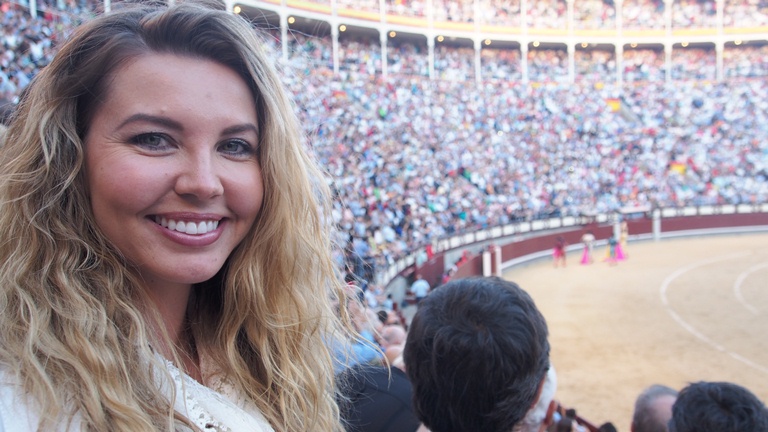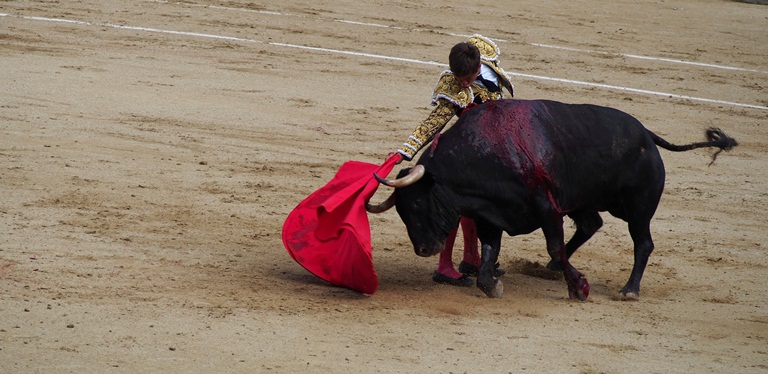Bullfighting in Spain: My Opinion of the “Artistic Tragedy”


As you approach the Plaza del Toros de Las Ventas, Madrid’s historical bullring, you will observe many individuals in the swarm of people who are also entering to watch this spectacle. Some are wearing fine suits and ties just fresh from the office. Others are in casual, but nice clothes. Old men are wearing fedora hats to keep the sun off their heads. Many women, young and old, carry un abanico (a fan) in hand.
As you pass through the main entranceway of Las Ventas, you can smell the cigar smoke and alcohol in the air. You push through the roaring crowd to begin your short journey down the corridor to your seat. As you walk, you can hear a man shouting over the noise and as you draw near to him you finally see what he is selling – seat cushions. A few special vendors are selling small souvenirs and books parallel to him.
As you begin to brace yourself and reflect on your fine choice for a seat, you hear the trumpets sound and are immediately overcome with mixed feelings of what is to come next.
Further down, you notice glass showcases displaying previous garments worn by some of the long past, most famous matadors Madrid has known. Some of them, the greatest, also have their names imprinted throughout the walls around the ring. Above your head, you see cartels (or posters) hanging from the ceiling with the names of the matadors who will appear in the ring. Open bars are located next to each doorway entrance. You ask the bartender, “Me puedes dar una cana, por favor?” and pay 2.50 euros.
You finally walk out of the corridor and into the sun of the ring. You take your seat in the sol y sombra (sun and shade) section of the tenidado bajo (lower level section between the barrera and the covered upper level). As you begin to brace yourself and reflect on your fine choice for a seat, you hear the trumpets sound and are immediately overcome with mixed feelings of what is to come next.
At least that was my experience during my first corrida de toros (bullfight). Corrida de toros literally translates to “bull run” in English. However, in Spain this traditional art is much more. The fight is still very much alive for both man and bull when joined together in the plaza del toros (bull ring).

I didn’t think much of this idea before I moved to Spain. However, when I was confronted with the controversial topic of bullfighting, my curiosity intensified and I felt it was important enough to research. I came to realize it is not so popular among the “Generation X” crowd. “But why?” I asked. I assumed it was a long held tradition of this country and people my age, especially men, would jump at the chance to explain the tradition in detail. I was wrong. In fact, I found most of the population was split on their opinion or didn’t care either way. I found it rather difficult to find any person my age willing to attend a bullfight with me.
Before attending my first bullfight, since I clearly wasn’t to be accompanied to the ring by a knowledgeable expert, I wanted to learn a little about it first.
When I asked a person if they had seen a bullfight, I would receive the usual frown and stare followed by a reply similar to, “No, I don’t agree with torturing animals.” At that point, I had no opinion. I was bothered by the fact I couldn’t fairly choose to agree or disagree. I hadn’t the opportunity to witness one myself. However, their disapproval only sparked my interest more. I decided it was time to independently uncover this topic on my own.
In regards to bullfighting, my opinion is based on what I know from research and from my own personal experiences. People’s opinions will always differ, but it is much easier to respect one’s opposing view when they can definitively state why they believe as they do.
Before attending my first bullfight, since I clearly wasn’t to be accompanied to the ring by a knowledgeable expert, I wanted to learn a little about it first. I knew that Ernest Hemingway, the great American journalist, novelist and bullfighting aficionado, could enlighten me with his works. With limited time to read, as the end of Madrid’s bullfighting season was coming to a close the first week of June, I hurriedly bought two of Hemingway’s books – The Sun Also Rises and Death in the Afternoon.
Bullfighting in Spain: My Opinion of the “Artistic Tragedy”.
Again, let me intervene to say this. Regardless of whether you are a fan of bullfighting or not, if you are a fan of American literature, Spain, history or even love, yes love, I suggest you read Hemingway. His prose are extremely direct and lack the lavish caressing which most writers use to make a point, and this is why his writing is so well adored. He tells the rough truth of some of life’s most difficult situations and overshadows them with metaphors.
In The Sun Also Rises, you follow a group of World War I veterans, more or less, to a festival in Pamplona during the 1920s. Death in the Afternoon is strictly a story of bullfighting at its best and worst in the 1930s, with some interesting run-on tangents to keep you interested. If you are considering a bullfight in Spain, I suggest reading at least Death in the Afternoon as it will give you a nice historical overview of bullfighting with detailed information, which is still mostly relevant today. However, both books captured my attention and it was fascinating to pour over sentences concerning Spain’s people, culture, climate and general atmosphere while living in the country itself. Therefore, forgive me, but I’m going to quote him multiple times throughout this article because his words are properly fitting in my mind.
The Tradition
According to this website, forms of bullfighting have been traced to ancient Greek and Roman times. However, bullfighting was first organized into the formal art we know today as the corrida de toros in the 18th century and hasn’t changed much since then.
Question: Why are tourists spending a great deal of money each year to visit the ruins of the Colosseum in Rome, but when given the opportunity to see the same type of live spectacle in selective countries will shrill at the thought of it? A bullfight is in the same category as events carried out between gladiators and fierce animals, yet many of those same tourists would shun, much less, think about observing a bullfight.
The Short Story
It has been argued that the bullfight isn’t truly a fair one between man and bull, more specifically because of what happens to the bull in the first and second tercios. There are three tercios, or acts, as Hemingway calls them during each fight. He states specifically that, “Bullfighting is not a sport. It was never supposed to be. It is a tragedy. A very great tragedy. The tragedy is the death of the bull. It is played in three definite acts.” I think his comparison is fascinatingly true.
The introduction, presents the bull as the “main actor” that displays his might, strength and bravery by charging the capotes (the gold and magenta capes) held by toreros (who is any professional bullfighter: matador, banderillero or picador). The first tercio/first act has two picadors enter the ring on horseback. The bull charges towards them. The impact is given to the horse, who is somewhat armored with a peto (a gold-colored blanket) and material wrapped around his legs. The picador uses a pica (a long pole with a steel point on the end) to literally “pick” or stab the bull in the toughest area of his body – the hump of muscle on his back.
Goring? Yes, of course, goring happens – it’s a bullfight.
The second tercio/second act brings forth the banderilleros with the job of placing banderillas, six at most, also in this hump of muscle. A matador can employ his own banderilleros or he can be a banderillo himself. The point of the first two acts is to weaken the bull, a bit, so the fight is balanced. However, depending on orders from the matador, the result of these acts can be more or less severe for the bull. The third tercio/third act, of course, is between the matador (the formal word for killer of bulls) and the bull with the muleta (red cape) and sword.
Unfortunately, one part of the corrida I didn’t particularly enjoy for the horses was the first tercio. The horses, while armored, are blindfolded and unaware of what is about to happen to them. Indeed, they can be punctured by the bull’s horns if the impact of the charge is forceful enough or if the bull’s horns go underneath the peto. I saw a few horses walk away from the ring with bloodstains on their peto.
Although, it is interesting to note, they act essentially unshaken by their injuries. I’m not a horse whisperer nor do I know a great deal about horses and their levels of pain, but the fact that I was uninformed about the future of these horses made me feel uneasy. If you read Death in the Afternoon, Hemingway goes into detail about what happened to the picador horses in the 1930s. Optimistically, I would like to think they are sent to horse hospital to be patched up, but I fear there is a high probability many may end up in horse heaven.
Bullfighting in Spain: My Opinion of the “Artistic Tragedy”.
Goring? Yes, of course, goring happens – it’s a bullfight. This is normal and, in fact, something you must prepare yourself to witness if you plan to attend a bullfight. In addition, a torero can be gored if the bull is too wild for him to control or he is simply not a good torero.
The final tercio, to be a good one, must be balanced. The bull must be brave, without hesitation, intelligent and of decent size. In equal measure, the matador must be skilled to work the bull with his technical skills, knowledge and aesthetic passes with the muleta and sword to demonstrate his own bravery. The fight will be good this way and the bull will have his 15 minutes of fame and glory to die (or live) as a hero. Yes, it’s possible for a bull’s life to be spared if he shows enough valor. It is called an indulto, according to this website.
Additionally, this preserved breed of bulls produced for fighting live an ideal life building up to their final act. The fighting bull lives longer and healthier than the domesticated bull, between 3-5 years, in a natural environment. Then, when they are mature and sent to the bullring, their moment of purpose and glory lasts less than 20 minutes. Furthermore, the meat of the bull is processed immediately and sold to restaurants around Madrid.
My opinion
I did my best to go into this experience with an open mind without a biased opinion whatsoever, but sometimes these things are difficult to avoid when considering personal background, previous conversations with friends and my love of animals. In addition, I made no attempt to view videos, pictures or read gory details through newspaper articles or news stories. The only exposure I allowed was through Hemingway’s books, strictly informative articles. and brief conversations with Spaniards who had previously attended.
Conversely, with that being said, I enjoyed the corrida de toros. The range of intense feelings you possess, while obviously not as grandiose as the early 19th century bullfights, are still felt today. You cannot take your eyes away from the action as in one split second you can be pro bull or pro torero, given the situation. Every fight is different and with it comes various feelings mixed together.
Bullfighting Now and in the Future
The modern-day bullfights still attract crowds, especially on days where famous matadors, such as José Tomás and Julián “El Juli” López, are to be seen. Recently, On June 4th, I attended my first bullfight in Madrid. Not a seat was empty. King Juan Carlos was in attendance, just two days after his announcement of abdication. This art is definitely not going to die out soon in Madrid, but in other places, for example, it is erased completely.
Bullfighting is now banned in several regions of Spain, including Catalonia. However, most regions still allow it. There are many great cities where you can spot a plaza del toros and watch a bullfight, including Madrid, Sevilla and Valencia, to name a few.
Best time to go? I would suggest mid-spring to summer, but I hear August can be too hot! Also, it is normal to go alone or with an aficionado, but I suggest taking an expert with you to explain if you haven’t done your homework, except read this article, and just remember Hemingway, “bullfighting is not a sport…it symbolizes the struggle between man and the beasts.”
Sources and helpful websites:
• Overview of the evolution of bullfighting and links to many other sources of reading
• Information on the recent cancellation of a bullfight in Madrid (May 2014)
• General information on the details of a bullfight
Photos by Susan Gray.









I very much enjoyed this piece.I am fascinated by bullfighting but am yet to go.
I will write in more detail later. Have you plans to go to others and make this a regular thing Susan?
Susan, I’ve been to several bullfights in Seville, where I’ve lived for seven years. The cultura taurina down here is ever-present, so I went to my first corrida during my second year here to find out what it was about. Like you, I enjoy the pageantry and tradition, and find it beautiful to watch the skill and the dance. People might argue that it’s cruel, but when animals are slaughtered daily for meat (and, oye, I eat meat), where do we draw the line?
Great piece.